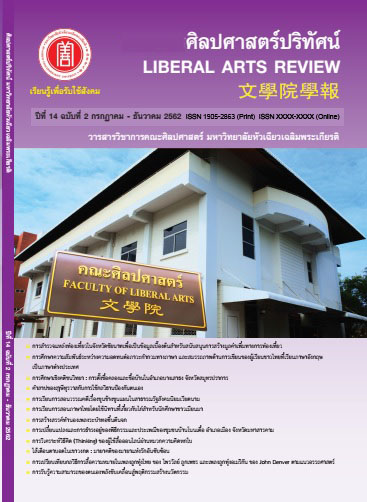Sai-duan Tabod Nai Kao Wongkot (Blind Mask in the Maze): Mythology in the Complex Love Illusion
Keywords:
Novel, Contemporary Literature, Sai-duan Tabod Nai Kao Wongkot, MythologyAbstract
This article aims to study plot and composition technique influencing signification of denotative meaning and connotative meaning or mythology in Sai-duan Tabod Nai Kao Wongkot or “Blind Mask in the Maze”, the first novel of Veeraporn Nitiprapa. A love triangle taken place in Thai society is used as the plot of the story. The technique of anti-realism in form of storyline rejection is used with symbol, word choice, narration, and plot twist. The readers are able to interpret both denotative meaning and connotative meaning or mythology through beliefs and culture illustrated in the story. The purpose of the use of anti-realism may be to arouse reader’s emotion which is the result of cognition use.
References
บาร์ตส์, โรล็องด์. (2547). มายาคติ (พิมพ์ครั้งที่ 2). (วรรณพิมล อังคศิริทรัพย์, ผู้แปล). กรุงเทพมหานคร: คบไฟ.
Hall, S.. (1997). Representation : Cultural Representation and Signifying Practices.London: sage.
Downloads
Published
How to Cite
Issue
Section
License
บทความที่ได้รับการตีพิมพ์เป็นลิขสิทธิ์ของวารสารศิลปศาสตร์วิชาการและวิจัย
ข้อความที่ปรากฏในบทความแต่ละเรื่องในวารสารวิชาการเล่มนี้เป็นความคิดเห็นส่วนตัวของผู้เขียนแต่ละท่านไม่เกี่ยวข้องกับมหาวิทยาลัยหัวเฉียวเฉลิมพระเกียรติ และคณาจารย์ท่านอื่นๆ ในมหาวิทยาลัยฯ แต่อย่างใด ความรับผิดชอบองค์ประกอบทั้งหมดของบทความแต่ละเรื่องเป็นของผู้เขียนแต่ละท่าน หากมีความผิดพลาดใดๆ ผู้เขียนแต่ละท่านจะรับผิดชอบบทความของตนเองแต่ผู้เดียว




